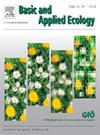Unpacking the fitness consequences of a warmer spring on an overwintering butterfly
IF 3.5
2区 环境科学与生态学
Q2 ECOLOGY
引用次数: 0
Abstract
Declining butterfly abundance over recent decades coincides with both habitat loss and increasingly warmer springs. Warmer temperatures could pose a problem for ‘capital’ breeders, especially those species that enter winter diapause as a pupa or adult, since a higher metabolic rate pre-eclosion is expected to further deplete lipid stores needed for egg production. We undertook an experiment on Pieris napi, a butterfly that overwinters as a pupa, to assess to what extent access to nectar as an adult could compensate for a loss in body conditioning due to a warmer (6 °C vs. 2 °C) and or longer (195 vs. 145 days) post-diapause treatment. We found that a warmer and longer post-diapause time significantly increased the proportion of body mass lost between pupation and adult emergence, which in turn reduced lifetime fecundity for females in the water control treatment. However, when given access to a sugar/honey solution, a higher rate of egg laying and an extended lifespan allowed females to offset any fecundity disadvantage. The full consequences of a warmer post-diapause treatment were partially obscured by an elevated rate of egg laying during the first week, presumably due to a preceding effect of temperature on metabolic rate. Structural equation modelling suggests that the direct and indirect benefits of feeding on nectar as an adult double lifetime fecundity. We conclude that while potential reproduction may be limited by the availability of essential fatty acids acquired as a larva, other nutrients available in nectar are needed to realise a potential fecundity advantage. In this sense, butterflies could be considered an ‘income’ breeder, which can benefit from conservation actions that aim to provision more nectar resources in spring.
在一只越冬的蝴蝶身上,打开温暖的春天带来的健康后果
近几十年来,蝴蝶数量的减少与栖息地的丧失和日益温暖的春天同时发生。温度升高可能会给“资本”育种者带来问题,特别是那些作为蛹或成虫进入冬季滞育的物种,因为在羽化前较高的代谢率预计会进一步消耗产卵所需的脂质储存。我们对一种蛹越冬的蝴蝶Pieris napi进行了一项实验,以评估成年蝴蝶获得花蜜可以在多大程度上弥补滞育后较温暖(6°C vs. 2°C)或较长时间(195天vs. 145天)处理造成的身体调节损失。研究发现,较长的滞育后温度显著增加了蛹化到羽化之间的体质量损失比例,从而降低了水分控制处理下雌蜂的终生繁殖力。然而,当给予糖/蜂蜜溶液时,更高的产卵率和更长的寿命使雌性抵消了任何生育劣势。滞育后温度升高的全部后果部分被第一周产卵率升高所掩盖,这可能是由于温度对代谢率的先前影响。结构方程模型表明,以花蜜为食对成虫的直接和间接的好处是其终生繁殖力的两倍。我们得出结论,虽然潜在的繁殖可能受到幼虫获得的必需脂肪酸的可用性的限制,但花蜜中可用的其他营养物质需要实现潜在的繁殖力优势。从这个意义上说,蝴蝶可以被认为是一种“收入”育种者,它们可以从旨在在春天提供更多花蜜资源的保护行动中受益。
本文章由计算机程序翻译,如有差异,请以英文原文为准。
求助全文
约1分钟内获得全文
求助全文
来源期刊

Basic and Applied Ecology
环境科学-生态学
CiteScore
6.90
自引率
5.30%
发文量
103
审稿时长
10.6 weeks
期刊介绍:
Basic and Applied Ecology provides a forum in which significant advances and ideas can be rapidly communicated to a wide audience. Basic and Applied Ecology publishes original contributions, perspectives and reviews from all areas of basic and applied ecology. Ecologists from all countries are invited to publish ecological research of international interest in its pages. There is no bias with regard to taxon or geographical area.
 求助内容:
求助内容: 应助结果提醒方式:
应助结果提醒方式:


